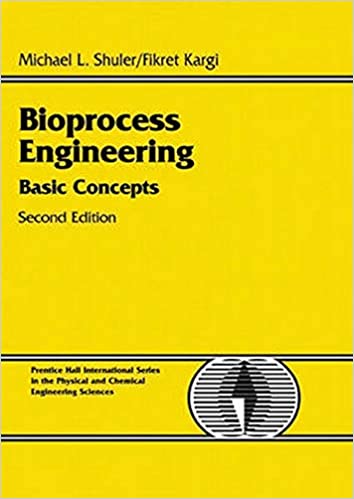
Bioprocess Engineering 2nd Edition by Fikret Kargi,Michael Shuler
Edition 2ISBN: 9780130819086
Bioprocess Engineering 2nd Edition by Fikret Kargi,Michael Shuler
Edition 2ISBN: 9780130819086 Exercise 11
5 The bioconversion of glucose to ethanol is carried out in a packed-bed, immobilized-cell
bioreactor containing yeast cells entrapped in Ca-alginate beads. The rate-limiting substrate
is glucose, and its concentration in the feed bulk liquid phase is
 The nutrient flow
The nutrient flow
rate is F = 2 l/min. The particle size of Ca-alginate beads is
 = 0.5 cm. The rate constants
= 0.5 cm. The rate constants
for this conversion are

for the following rate expression:

The surface area of the alginate beads per unit volume of the reactor is
 and
and
the cross-sectional area of the bed is
 Assuming a first-order reaction-kinetics
Assuming a first-order reaction-kinetics
(e.g., relatively low substrate concentrations), determine the required bed height for 80% con-
version of glucose to ethanol at the exit stream. Hint: To calculate the effectiveness factor, we
can use the following equations:

bioreactor containing yeast cells entrapped in Ca-alginate beads. The rate-limiting substrate
is glucose, and its concentration in the feed bulk liquid phase is
 The nutrient flow
The nutrient flowrate is F = 2 l/min. The particle size of Ca-alginate beads is
 = 0.5 cm. The rate constants
= 0.5 cm. The rate constantsfor this conversion are

for the following rate expression:

The surface area of the alginate beads per unit volume of the reactor is
 and
andthe cross-sectional area of the bed is
 Assuming a first-order reaction-kinetics
Assuming a first-order reaction-kinetics(e.g., relatively low substrate concentrations), determine the required bed height for 80% con-
version of glucose to ethanol at the exit stream. Hint: To calculate the effectiveness factor, we
can use the following equations:

Explanation
The bioconversion of glucose to ethanol ...
Bioprocess Engineering 2nd Edition by Fikret Kargi,Michael Shuler
Why don’t you like this exercise?
Other Minimum 8 character and maximum 255 character
Character 255


